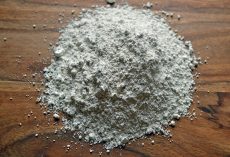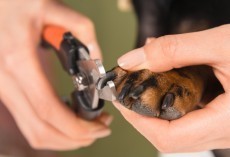Hip dysplasia is caused by slackness in the hip joints. If the bones do not sit as they should, friction begins and causes deterioration, which eventually leads to damage in the hip area. Dogs can either be born with dysplasia or it develops in later years. It is caused by both hereditary and environmental reasons.
Breeds Affected
Hip dysplasia can affect all breeds, including mixed breeds. However, it is affects large and giant breeds more commonly than small ones. Some breeds are more genetically susceptible to hip laxity have higher instances of hip dysplasia, such as:
German Shepherds
Golden Retrievers
Labrador Retrievers
Rottweillers
Great Danes
Saint Bernards
Mixed breedsSymptoms
Symptoms depend on the degree of joint looseness or laxity, the degree of joint inflammation, and the degeneration present. It's important to note that the pain levels in a dog do not always corrolate with the disease's progress. Some dogs with mild dysplasia may experience extreme pain. Whereas dogs with severe dysplasia may appear to be coping quite well.Common signs of hip dysplasia include:
Exercise intolerance
Bunny hopping (especially up stairs)
Swaying gait (rear end moves back and forth in pronounced fashion)
Stiffness/pain
Difficulty getting up from lying or sitting positions
Sitting in “frog” position (one hip splays out)
Reluctance to run, jump, climb stairs
Evinces pain when touched
Hind-limb lameness, often worse after exercise
Back legs more close together than front legs (eg narrow stance)As hip dysplasia progresses the following symptoms may appear:
Muscle waste in the hind quarters
Arthritis (especially in later onset)
Very reluctant to be touched
Unexplained aggressive behavior (read more on sudden aggression, and the high probability of hip dysplasia)Diagnosis
Veterinarians will examine a dog and look espcially at joint looseness (or laxity), in the hips, which is an early indicator of the disease. In older dogs they will look for a loss of muscle mass in the thigh muscles and enlargement in the shoulder muscles (due to muscle compensation).The primary test will a laxity test (Ortolani sign). For this, a dog will likely be given a general anaesethic so that the vet can rotate the hip joint without causing discomfort to the dog.
X-rays are critical to see how far advanced the degeneration is and if it has affected the dog's spinal cord in any way.
The vet will also take a blood chemical profile, which includes a blood count, electrolyte panel and urinalysis. Any information you may have on your dog's lineage/parentage is also helpful. However, it should be noted that a dog's parents can be completely clear of hip dysplasia and still produce dysplastic offspring.
The earlier the disease is diagnosed, the better the treatment options available. This is because the longer the condition continues undiagnosed, the further the degeneration of the joints will occur.
If you suspect your dog may have hip dysplasia, or you have a breed of dog more prone to the disease, bring him/her to a veterinarian for diagnosis.
Treatment
Treatment of hip dysplasia can be treated either conservatively or through surgery. Treatment options will often depend on the dog's age, size and the progression and the type of dysplasia (if it is early or late onset). The severity of the joint looseness will factor into whether to go the route of surgery or conservative therapy.Outpatient/Conservative Therapy
Conservative therapy includes medication and physical therapy as a means of management of the disease. This can include:*Hydrotherapy is good for dogs with hip dysplasia
*Weight control. If a dog is overweight, weight control helps with recovery, as it decreases the pressure applied to the painful joint and reduces inflammation. You and your veterinarian will come up with a plan to minimize any weight gain. In puppies, special diets designed for rapidly growing large-breed dogs may also decrease the severity of hip dysplasia by helping the puppies bones and muscles grow at an appropriate speed for proper development.Pain relief medications (analgesics)
For osteoarthritis, degenerative arthritis medications called polysulfated glycosaminoglycans or PSGAGs may be prescribed (e.g. pentosan polysulphate). These medications are naturally occurring components of the joint cartilage and increase joint fluid production. It is recommended to keep an arthritic pet warm and out of cold, damp and drafty environments in order to be more comfortable. Orthopedic foam beds also help many dogs with arthritis.
Surgical Treatments
There are several forms of surgery that are employed for treating hip dysplasia. Your veterinarian will make recommendations based on the age and condition of your dog.
Just remember, if you are looking for a hip dysplasia free dog from the beginning it’s always a good idea to adopt from a responsible breeder – and avoid the pups above. Basically, if two pooches who have good lines, no hip dysplasia in their family history, then you are probably safe. However, such a thing can never be guaranteed. It’s all in your pup’s genes.
Also, you'll want to avoid puppy mill operators. It may seem as though we're stating the obvious here, but remember – puppy mills are in business because people continually buy from them. In addition to the terrible environment and all the bad ethics surrounding puppy mills, the owners pay little attention to the causes or the genetic health of their dogs. Because of this, hip dysplasia is VERY common among puppy mill dogs.
For more information about hip dysplasia, its causes and cures, please go to Dog Heirs. They have additional advice and information. Meanwhile, take a good look at your dog and if you notice the symptoms listed above act immediately!









